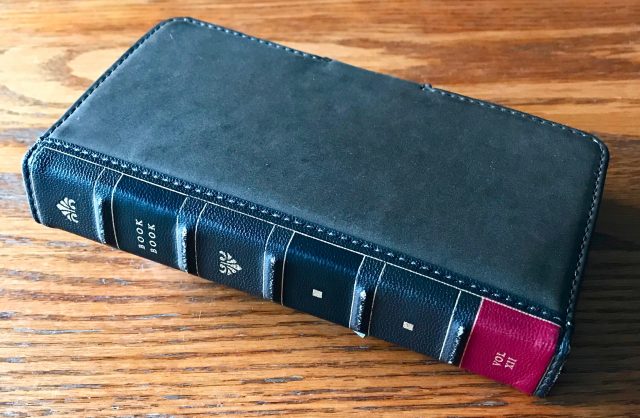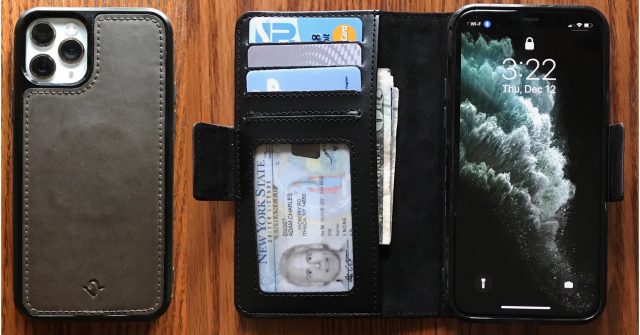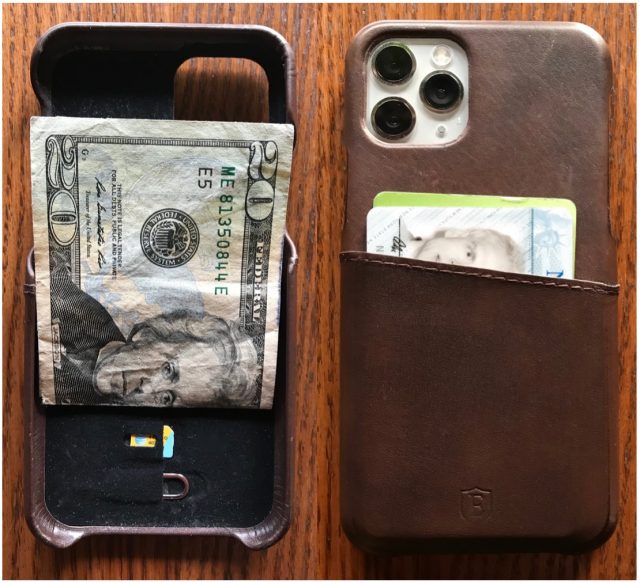Two Wallet Cases: Twelve South BookBook Vol. 2 and Ekster iPhone 11 Pro Case
With each new iPhone model, it seems that Apple changes something that requires us to purchase a new case. Perhaps the dimensions change slightly, or maybe the cameras occupy more space on the back, or a button moves a few millimeters. (We won’t even get into the question of why Apple’s Jony Ive-led designers moved away from the thicker, more squared-off design of the iPhone 5 era, which was less slippery and enough easier to hold that many people went without cases entirely.)
So when I ordered an iPhone 11 Pro, I knew I would need a new case, and I decided to try something a little different. For several years, I’ve used wood-backed cases from Carved, but while they were attractive, protective, and gave me a grippy surface so I didn’t drop the iPhone, they offered no additional functionality.
Plus, I had grown weary of carrying both my wallet and my iPhone every time I left the house. I have long been the slightly obsessive sort who carries every card that I might need with me at all times, even though in real life, I mostly use only a single credit card. Could I downsize to an iPhone wallet case?
Two opportunities soon presented themselves. Twelve South came out with a new version of its BookBook case that makes the iPhone look like a tiny book, and Ekster released a leather iPhone wallet case that cleverly included internal slots to hold a SIM and a SIM extraction tool, ideal for frequent travelers or anyone who needs to swap SIMs regularly.
Twelve South BookBook Vol. 2
Twelve South has developed versions of its BookBook case for a variety of Apple devices. The conceit is that, when closed, the case looks like a leather-bound book, much as a book safe might attempt to nestle, undetected, in a shelf of books. It’s hard to imagine the disguise fooling people in a big way, but it’s an unusual, elegant look.
For the BookBook Vol. 2 iPhone case, Twelve South separated the “cover” of the book folio from the iPhone, encasing the iPhone in a standalone plastic and leather-backed shell that protects the iPhone when you remove it from the BookBook cover. The shell protects the back and all four edges of the iPhone, and it’s slightly raised in the front to keep the iPhone screen off flat surfaces when you set it face down. Cutouts provide access to the ringer switch, the Lightning port, the mic and speakers, and the cameras in the back—the side button and volume buttons are covered with flexible plastic. The shell is reportedly compatible with wireless charging.
The inside of the front cover provides four slots to hold ID and credit cards, each of which can hold one or two cards, and a pocket can hold a number of folded bills. Don’t get carried away, though. If you put too many cards and bills in, the BookBook doesn’t close properly. The bottom slot has a plastic cover with a cutout that makes it easy to extract its card with a slide of your thumb through the cutout.
The iPhone shell attaches to the BookBook’s back cover, which has magnets that work with metal plates in the shell to make it easy to attach and detach the iPhone. A magnetic tab keeps the BookBook cover closed. (Twelve South says the magnets won’t cause problems for credit cards due to the design, and I experienced no issues during my usage.) A built-in viewing stand makes it possible to prop up your iPhone in landscape orientation—it’s a little tricky to figure out the first time or two.
Twelve South recommends putting the titanium Apple Card in the card slot with a clear plastic window, partly to keep the Apple Card stain-free (it may be bulletproof, but it’s easily marred), and partly to ensure that the titanium metal doesn’t scratch the iPhone screen.
The combination of the folio cover and the iPhone shell works well. It’s trivially easy to pull the iPhone out when you don’t need the rest of your wallet and put it back in when it’s time to leave the house. I could easily store four or five cards and some bills in the BookBook case, so I didn’t feel anxiety about leaving a potentially important card home.
There’s only one problem. Putting the iPhone in the BookBook case makes for a rather thick package, not something that you would want to slide into and out of your pants pocket regularly. I carry my iPhone in my front right pocket at all times, and although I could wedge the full BookBook case into my pocket, it wasn’t easy or comfortable, and I found it awkward to have to open the case each time. But if you carry your iPhone in a purse or suit jacket pocket, the thickness probably won’t bother you.
The Twelve South BookBook case costs $69.99 and is available for all three iPhone 11 models. The original BookBook case remains available for the iPhone 7/8 Plus and the iPhone X series for $59.99.
Ekster iPhone 11 Pro Case
I’ll admit that what attracted me to the Ekster iPhone 11 Pro case was its claim that it included a slot for a SIM and a SIM extraction tool inside. On our past two trips to Europe, keeping track of the minuscule SIM and tiny tool was quite stressful (see “UK Travel Tips: Giffgaff for Cellular and Apple Pay for Transit,” 15 June 2018, and “Orange Holiday Europe: A Cheap 4G SIM for Your European Vacation,” 22 July 2019).
The Ekster wallet case is otherwise simple. Like the BookBook’s leather iPhone shell, Ekster’s entry is a leather-encased plastic shell that covers the back and edges of the iPhone and keeps the iPhone screen off the table when you set it face down. The premium leather edges make for a nicer feel than the BookBook’s plastic edges. Cutouts provide access to the side button, the volume buttons, the Lightning port, mic, and speakers, and the iPhone 11 Pro’s cameras on the back. It‘s also reportedly compatible with wireless charging.
There are indeed little slots on the inside for the SIM and the SIM extraction tool. It’s easy to put them in, but quite a bit more challenging to get them out, given how small they are. I worried slightly that the metal tool would scratch the back of the iPhone, but that didn’t prove to be a problem even before I realized that Ekster intends for you to put your cash between the iPhone and the back of the case, covering the tool.
Most notably, the back of the leather case has a pocket that can hold two cards comfortably. Ekster’s specs say one card, but I’ve had no trouble with two, and I don’t feel comfortable driving without my license on me. You might be able to jam one more card in there, but it’s already tight with two. There’s nothing unusual about this design—lots of cases rely on something similar—but it is generally functional.
The Ekster case has become my go-to case because it doesn’t add so much bulk to the iPhone that it’s a problem to get it in and out of my pocket many times per day. When I go out, I usually don’t have to think about bringing my wallet because I know that I have my driver’s license and my primary credit card with me, along with two $20 bills.
Of course, there are exceptions. If I’m going to go to a doctor’s appointment, for instance, I grab my old wallet containing my full set of cards, so I’m sure to have my insurance card. When I travel, I also make sure to bring the old wallet so I have the insurance card, additional credit cards in case something goes wrong with the main one, and more cash. Only once so far in six weeks of regular use have I lacked sufficient cash for the day, and I haven’t yet needed an additional card that I didn’t have with me.
My only criticism is that constantly rubbing the edge of the credit card against the inside of my pocket is slightly damaging the card, causing the laminated top coating to peel off. My New York State driver’s license appears to be solid plastic without a laminated coating, so I’m trying to keep it on the outside to protect the credit card. A design that completely covered the cards would be preferable, but it would need to provide a way to extract them easily. Also, I don’t carry my Apple Card, but it’s possible that the leather of the Ekster card slot would stain it over time.
The Ekster iPhone 11 Pro case costs $49, and it comes in Juniper Green, Classic Brown, Nappa Black, and Merlot Red. Note that it’s available only for the iPhone 11 Pro, not the iPhone 11 or the iPhone 11 Pro Max, although Ekster also makes a similar case for the iPhone X and iPhone XS.



With respect to worrying about SIM cards and tools for travel:
How did you do that?
Ooo, that’s a good idea—I have a few of those around still next time we go abroad, if there’s a SIM involved.
It would be nice if these prepaid SIMs could be done via eSIM.
I had the conversion done at an AT&T store. There may have been a nominal charge (<=$10). I believe that with both AT&T and Verizon, you can have it set up by calling their service lines and getting a QR code sent to you. I found a description of this procedure for Verizon here.
The Bellroy 3 card case is similar to the second case you tried and protects the cards while fitting 3 of them.
I’m guessing you mean this one:
It’s a bit more expensive than the others that I reviewed, but it has both the SIM card and tool slots, and the cards aren’t exposed as they are in the Ekster case.
Well worth a look for anyone shopping in this category!
Yes exactly. I use the iPhone X version of this case and it works great. Also supports wireless charging.
Good heavens, I’ve been using a wallet case (albeit a ‘folding’ model) with my iPhone for ages!
I’m one of those who prefer a small enough phone to fit into my pocket, and with a wallet case, I can hop on my trike (with a big basket in the back for errands and grocery shopping, for example) with all that I need – driver license (in a see-through slot), (medical) insurance card, CC and debit cards, some cash, my business card, even an RFID-blocking card from SignalVault.
In fact, both my elderly parents have them, too, which contain their Medicare and Medicare Supplement cards in addition to photo ID/DL, credit/debit card and cash. A godsend especially for mom, who otherwise would have to look for all those items in her, uh, pocketbook/handbag – always a nightmare either at the doctor’s office or at the check-out

And since everything is kept inside the (folding) wallet case, there’s no risk of anything getting damaged on the outside.
Moreover, since I’m esthetically ‘conscious’, I even have matching cases for my other iDevices – or iToys as my mother calls them!
Finally, since I travel mostly overseas, I use the SD slot in my (also RFID-blocking) passport case for the SIM tool and other SIM cards. Somehow that makes me feel a little easier than having the SIM cards with the phone…
The folding models work well for carrying a lot of stuff—my father uses one—but whenever I’ve tried one, I found it too awkward to be moving the cover out of the way every time I wanted to use the iPhone.
I like the SafeSleeve. It has room for 3 cards and some bills, seems well-made, and shields you from radiation when you are talking on the phone. It was about $35 when I bought it (on sale).
Well, my mom who’s a great photographer actually has a folding model that allows the phone to be removed easily. (The phone sits in its own ‘case’ that‘s attached to the wallet case with strong magnets.) I’ve used both kinds – detachable and non – and methinks there’s probably a solution for every ‘whim’…
Whatever the case (no pun intended), it never ceases to amaze me just how inventive (some) people can be. What’s that they say, you didn’t know you needed something until you saw it?!?!?!?
Update:
Oops, just reread your original article. What my mom has is indeed like the BookBook, with a detachable shell for the phone itself,
Maybe I shouldn’t have said ‘folding’ in my original reply since all 3 cases here (my own, dad’s and mom’s) are like the BookBook, though only mom’s has the detachable shell for the phone itself… My bad!
Adam, would you check if your iPhone’s magnetometer operation is affected by the magnetic latch? Perhaps compare Apple Compass app headings on a pair of parallel-oriented phones, one with and one without the magnetic latch case. Try a few several orientations and, of course, with phones not close together so one isn’t near that latch magnet.
It’s a folio case, correct?
I didn’t have two phones handy, but testing with my iPhone 11 Pro both in the case and out of the case revealed that the only difference seems to be that the case prevents the exact number of degrees from showing. The actual heading seems correct regardless.
The left shot below is the iPhone 11 Pro in just the shell (which is the same as not in the shell at all), and the right shot is the iPhone magnetically attached to the BookBook folio.
Yes, that’s the one, and it is a folio case. The question about the magnetometer showed up on my feed just after this, and so I checked the SafeSleeve, since it has a magnetic latch as well. The compass was way off, like 180°! It
stayed off when I removed it from the case (plastic shell is attached to leather case), but when I restarted the phone, out of the case, it corrected itself. 5 minutes after I put it back in the case it was off again. The maps work ok, but the phone doesn’t
know which way it’s facing. (Interesting, the interaction between GPS and the magnetometer in those apps.) I don’t know whether it’s the magnetic latch or the radiation shielding that’s doing it, I’ll communicate with the company.
Later: My wife has a folio case with a magnetic latch, but her compass works perfectly. So it most likely is the shielding. (Proves it’s effective . Haven’t heard back from the company, but wouldn’t expect to yet. Will post their response if it’s interesting.
. Haven’t heard back from the company, but wouldn’t expect to yet. Will post their response if it’s interesting.